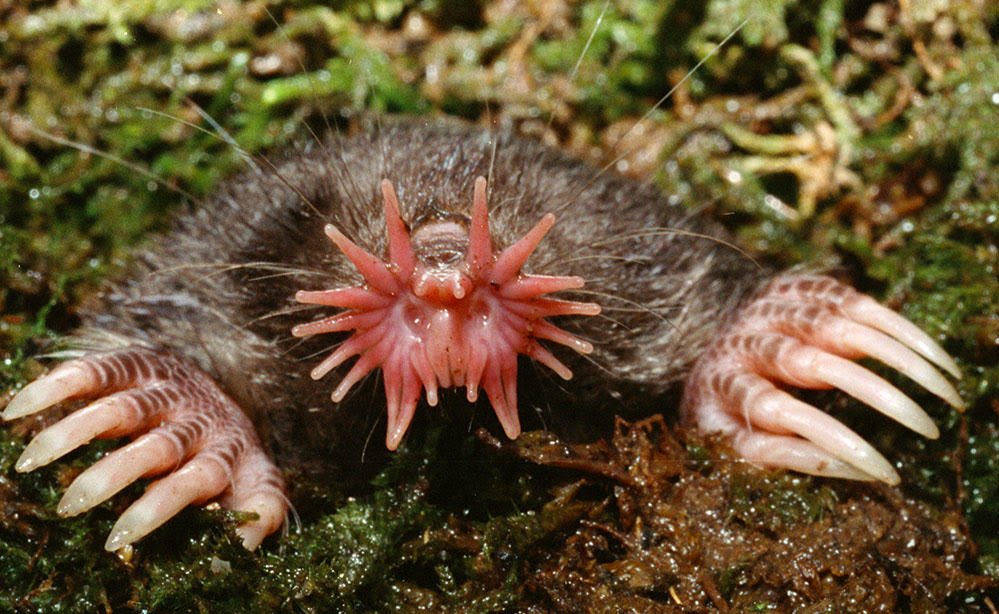Here’s a riddle:
I touch with 22 fingers…
I can see in total darkness…
I can catch and eat my prey faster than you can blink…
I can smell inside a bubble…
And though you might never have met me, I’m your neighbor, and you’ve probably stood right outside my walls.
Who am I?
A fantastic chimerical beast of legend? Good notion, but no. Maybe some human lesson veiled in tricky metaphors, as if by the Sphinx? Also plausible, but wrong again.
The answer, amazingly, is an actual animal, seemingly too strange to be true, but alive and real. Meet the star-nosed mole.
The riddle’s answer lies in the mole’s remarkable snout. The star consists of 22 fleshy pink appendages, or “rays,” which radiate from the point of the mole’s narrow nose, in arcs of 11 around each nostril. Each ray is covered with tiny bumps called Eimer’s organs, which contain specialized nerve endings for detecting shapes and textures. Each star, with about 25,000 Eimer’s organs, has six times more sensory neurons than an entire human hand.
Neurobiologist Kenneth Catania of Vanderbilt University has noted astonishing analogies between the mole’s touch perception and the eyesight of surface-dwelling animals, including humans. The mole browses its dark network of tunnels, pressing the star rapidly here and there against the walls to generate a broad scan, just as we build a mental image of our surroundings by shifting our eyes from spot to spot. When any ray touches a possible food item, the mole then applies subsequent touches with the two most sensitive rays, at the bottom center of the star. Like the fovea of the retina, these central rays are relatively small but have disproportionate nerve density and processing area in the brain, thus allowing the mole literally to focus on objects of interest, but with touch instead of sight.
Immediately after these ultra-sensitive rays zoom in and confirm something edible, they part to make way for the mole’s tweezer-like front teeth to snap up the prey. The mole carries out this whole process, from identification to ingestion, with speed unmatched by any other known mammal — as fast as 120 milliseconds, or more than twice as fast as a blink of your eyes. Such speed, Catania suggests, has allowed the mole to adopt an expanded diet, including very tiny prey that wouldn’t provide sufficient caloric reward to be worth the time of slower foragers.
Aside from its singular snout, the star-nosed mole also differs outwardly from other mole species by its unusually long tail. In winter and spring, the tail thickens with fat deposits, which may serve as energy storage or a means of heat retention. Otherwise, the star-nosed mole looks much like other moles, with very thick, dark fur and short, strong forelimbs with long claws for digging. Star-nosed moles have tiny eyes, which probably serve only to distinguish light from dark.
Star-nosed moles live throughout eastern North America, from central Canada to the Atlantic, south to the coast of the Carolinas and Georgia. Star-nosed moles are common in the Finger Lakes region, but are rarely seen because they spend almost all of their time under the surface, out of view.
More than other mole species, they favor areas with wet soils, such as moist woods, edges of ponds and waterways, marshes, and poorly drained meadows. These soft, saturated soils were likely a defining factor in allowing the star to evolve with such complexity and exquisite sensitivity, as mole species that live in drier soils have tougher snouts with fewer Eimer’s organs. Star-nosed moles can dig approximately 8 feet per hour, with tunnels extending from the surface to depths of up to 2 feet. Active year-round, they also create tunnels through snow.
The tunnels of star-nosed moles often open directly underwater. Unlike other moles, they are strong swimmers, propelling themselves with powerful alternating forepaw swipes. Remarkably, the star-nosed mole is the first mammal, along with the water shrew, with the known ability to smell underwater. It does so by blowing bubbles through its nostrils onto submerged objects or scent trails, then quickly inhaling the bubbles back in, several times a second. The mole can stay underwater for about ten seconds before having to catch a breath at the surface.
So, no, the star-nosed mole is not a mythical creature, nor an allegory, nor a crazy flight of imagination. Indeed, thanks to the discoveries of science, it’s even becoming less and less of a riddle. Rather, it’s a marvelous reality of our world – utterly unique and practically right next door.


